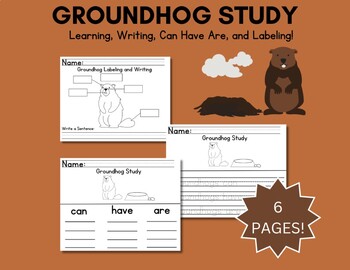Groundhog Research Study- Science Learn: Labeling, Writing, Can, Have, Are
madebymissgibbs
24 Followers
madebymissgibbs
24 Followers
Also included in
- Animal Research Bundle! I will be adding more and more animals!Buy now and save!Included:Penguin ResearchPolar Bear ResearchReindeer ResearchSnowman Research Bear ResearchWolf ResearchGroundhog ResearchPrice $12.00Original Price $14.00Save $2.00
- Groundhogs Day Activity Bundle Includes:- Groundhogs Day Coloring Pages- Groundhogs Day Craft- Groundhogs Day Research Study- Groundhogs Day Data Collection, Prediction, and WritingSuper fun and engaging activities to help students learn and understand the meaning of groundhogs day and make predictiPrice $5.00Original Price $7.00Save $2.00
Description
Fun Groundhog Research Study ready to go They can fill out the can, have, are sheet on facts they learn about groundhogs, and write sentences about each. Practice writing a fact at the bottom of each page. Great for learning and practicing researching an animal. Learn and practice reading and writing at the same time. Great connection for science.
Check out my Groundhogs Day Craft for more Groundhogs Day Fun:
Total Pages
6 pages
Answer Key
Does not apply
Teaching Duration
N/A
Report this resource to TPT
Reported resources will be reviewed by our team. Report this resource to let us know if this resource violates TPT’s content guidelines.
Standards
to see state-specific standards (only available in the US).
CCSSK.G.A.2
Correctly name shapes regardless of their orientations or overall size.
CCSSK.G.A.3
Identify shapes as two-dimensional (lying in a plane, “flat”) or three-dimensional (“solid”).
CCSSK.G.B.4
Analyze and compare two- and three-dimensional shapes, in different sizes and orientations, using informal language to describe their similarities, differences, parts (e.g., number of sides and vertices/“corners”) and other attributes (e.g., having sides of equal length).
CCSSK.G.B.5
Model shapes in the world by building shapes from components (e.g., sticks and clay balls) and drawing shapes.







